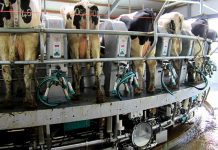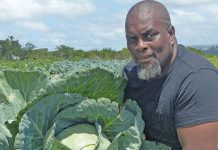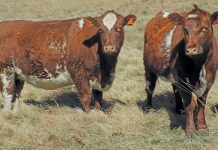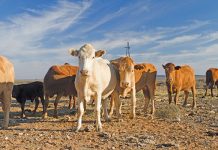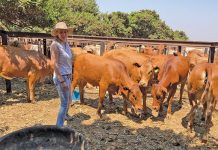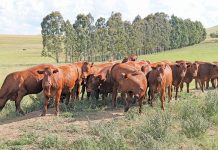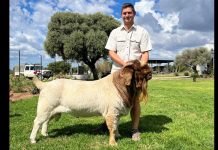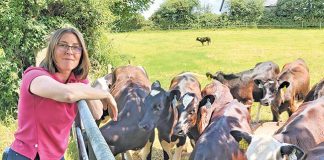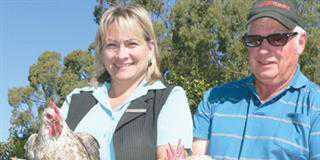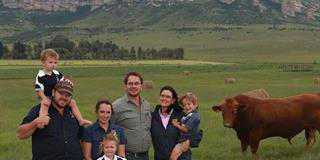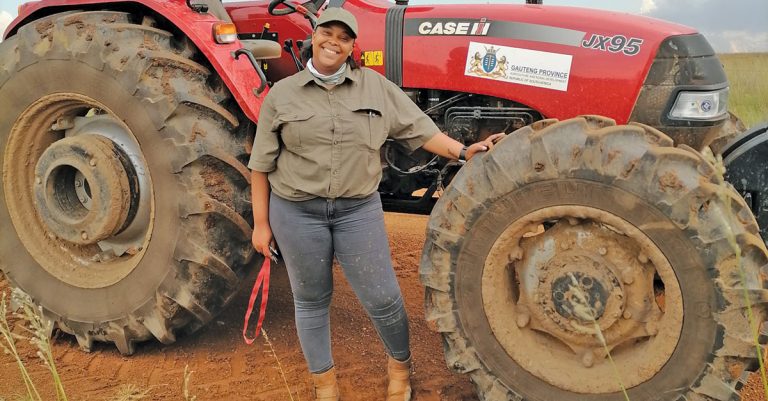
Photo: Siyanda Sishuba
Keneilwe Raphesu (24), director of Mogalemone farm in Holfontein, Gauteng, runs a mixed operation on 405ha.
Yellow maize and sugar bean are rotated on 200ha, Smuts finger grass is planted on 5ha, and the rest of the land is used to run 57 cattle and more than 50 pigs. While the farm belongs to her father, Raphesu manages the day-to-day operation.
She grew up in Ga-Mokgopo, Limpopo, and moved with her family to Vanderbijlpark, Gauteng, in 2007. In the same year, her father received Mogalemone farm from the then Department of Land Reform and Rural Development, and farmed here part-time until he signed a lease agreement in 2013.
Formal training
Raphesu was keen to join her father on the farm, but was determined to boost her skills before doing so.
“I learnt a lot from my father, but I wanted to go out there and empower myself to add more value to the farm,” she says.
To this end, she joined the Sernick Emerging Farmer Development Programme in January 2020, completing it in September of the same year. The Sernick Group, in partnership with the Jobs Fund, trains emerging farmers in cattle breeding and equips them with the necessary skills to become profitable commercial cattle farmers.
In Tier 1 of the programme, 660 farmers receive SETA-accredited training, and an opportunity to exchange their old stock with good-quality cattle that fetch higher prices. The minimum requirement is to own at least 40 cattle and land to run them on.
From those 660 farmers, 300 are chosen for Tier 2, where they learn to develop their herds while maintaining a healthy cash flow.
Fifty farmers move on to Tier 3, and are upskilled to viable commercial entities with their own reproductive capacity.
The programme is open to black emerging farmers who run herds within 150km of Kroonstad in the Free State.
Farm development
“When you apply to the programme, an officer from the programme comes to your farm to ensure you have the required cattle and land. [Throughout the programme], inspection of the farm’s progress is ongoing,” says Raphesu.
“After completing the course, you receive funding to develop your farm: R4 000 for the owner of the farm and R3 500 for the person who attended the course. I used the money to erect fencing.”
The funds also helped Raphesu change from mixed cattle to Bonsmara. She adds that the programme taught her a great deal about animal production and evaluating the animals’ body condition using the ‘hands-on’ method.
According to Raphesu, the productivity of beef cattle depends largely on the amount of fat they carry. Cows maintained in the right condition with an ideal layer of fat cover will produce more calves than thin or obese cows.
“With just my hand, I can feel for fat cover at the short ribs, spine, hooks, pins, and either side of the tail head. An animal in ideal condition will have a thin layer of fat in these areas, so it will take some pressure to feel the bones. An underconditioned animal’s bones will be quite prominent and sharp. In an obese animal, you won’t be able to feel any of the individual bones through the thick layer of fat.”
Changing the breed
Prior to switching to Bonsmara in February 2021, Raphesu ran a mixed herd of Braford, Beefmaster, Simbra and Brahman cattle. She changed to Bonsmara because of the quality of the meat.
To establish the new herd, she bought heifers and a bull from different breeders in Vredefort in the Free State. With the money made from the sale of her other cattle, she bought vaccines and feed, and covered the transport costs of the Bonsmara.
“I buy heifers at 18 months old when they’re ready to start mating. I look for animals with a smaller structure and body weight; bulls mustn’t be too muscular or they’ll struggle during mating,” she says.
Her five-year goal is to establish a feedlot, but for this she requires more land. She is also working towards opening an abattoir and butchery.
“When I get close to 1 000 cattle, I’ll know I’m getting there. I’m working hard to become one of the Tier 3 farmers in the programme, and I dream of being an auctioneer, too,” she says.
Production
Raphesu aims to produce animals with more muscle than fat, which is why she employs a semi-intensive feeding programme. Because the animals are run on sweetveld, feeding them in summer is not a problem, as they can survive on grazing. In winter, however, they receive feed twice a day.
Raphesu mixes her own feed, which includes molasses and yellow maize. The animals also receive Smuts finger bales. Each cow receives 25kg of the mix in the morning and again in the evening. They also have a winter lick.
The cattle are kept in four camps of 13ha, 17ha, 60ha and 100ha respectively. The carrying capacity is around 3ha/1 MLU, and the area receives 75mm to 100mm of rain annually.
During the breeding season (November to January), the cows and the bull run together in one of the camps, with the bull servicing around 26 cows in one season.
Female animals not being mated are kept separate. After mating, in-calf animals are placed in their own camp, and the bull is moved to a separate camp. Female animals are tested for pregnancy at the end of February. Those that have not conceived are artificially inseminated and tested again in April/May.
“Semen is bought-in from [other] Bonsmara breeders, and we also extract semen from our own bull,” she says. “Our conception rate is close to 95% and the calving rate is 100%. We generally produce more bulls than heifers.”
As most of the currently in-calf animals are heifers, Raphesu monitors them more closely, especially when they calve.
Calving occurs from August to September. Raphesu says the mating and calving seasons are timed to coincide with the period of sufficient grazing.
Calves are weaned at six to eight months. Young bulls remain in their own camp until they go to market; heifers join their dams in their camps. Heifers not kept are sold at auction or to an abattoir in Holfontein.
In line with legislation, Raphesu brands and tags all her animals. This also helps to prevent inbreeding, she says.
Email Keneilwe Rapheshu at [email protected].

